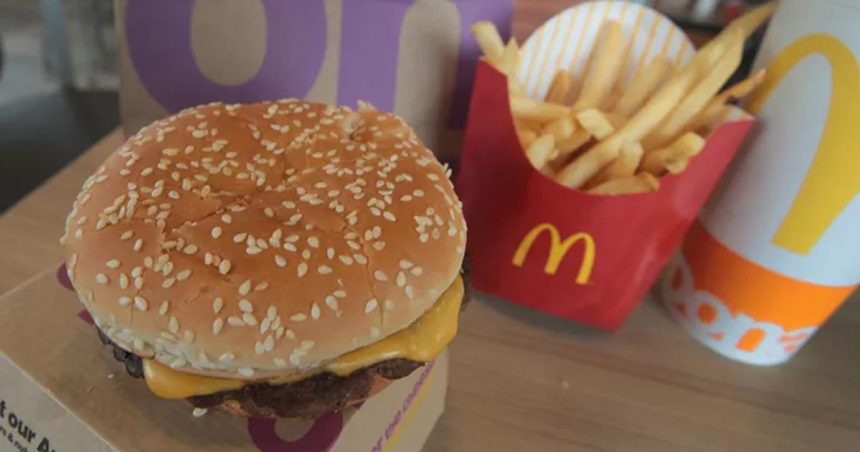An E. coli outbreak connected to McDonald’s Quarter Pounder has tragically resulted in one fatality and ten people being hospitalized. The Centers for Disease Control and Prevention (CDC) are currently investigating 49 reported cases of illness across ten states. In response, McDonald’s has quickly removed potentially contaminated ingredients from its restaurants in several states as health officials work to identify the source of the contamination. This outbreak underscores ongoing concerns about food safety in fast-food chains and the serious risks associated with E. coli infections, particularly for vulnerable populations.
The E. Coli Outbreak

The outbreak, initially reported on September 27, has predominantly impacted residents of Colorado and Nebraska. The CDC has warned that the actual number of affected individuals could be higher, as many cases often go unreported or undetected. In an announcement on October 22, the CDC confirmed the death of an elderly individual in Colorado and the hospitalization of a child with severe kidney issues.
While E. coli outbreaks are not unusual, the specific strain involved, E. coli O157:H7, is recognized for causing severe illnesses like hemolytic uremic syndrome (HUS), which can lead to kidney failure. McDonald’s Quarter Pounders have been linked to most of the illnesses, with slivered onions being identified as a potential source. Investigations are ongoing, with public health agencies like the FDA and USDA closely collaborating with McDonald’s to trace the contamination.
McDonald’s Response

Responding to the E. coli outbreak, McDonald’s has promptly removed slivered onions and Quarter Pounder beef patties from affected areas such as Colorado, Kansas, and Utah. Cesar Piña, McDonald’s North American chief supply chain officer, assured that the company is actively working with authorities to contain the infection. “We prioritize food safety and are collaborating with our suppliers to address this issue,” Piña stated.
McDonald’s has also ceased the distribution of slivered onions from a single supplier suspected of involvement in the contamination. This precautionary step applies to restaurants in multiple states, including Wyoming and Idaho. However, other beef products like the Big Mac and Double Cheeseburger remain unaffected and available nationwide.
Public Health Impact

The CDC has advised individuals who have consumed McDonald’s Quarter Pounder hamburgers and are experiencing symptoms of the E. coli outbreak like severe stomach cramps, bloody diarrhea, and vomiting to seek immediate medical attention. In severe cases, especially those with HUS, the consequences can be life-threatening, especially for children and the elderly.
Anyone feeling unwell after eating a Quarter Pounder is urged by the CDC to promptly seek medical help. While most recover within a week, some cases require hospitalization. Individuals such as young children and older adults are at higher risk of severe outcomes.
Read More: McDonald’s Customers Are Shocked After Realizing What Sweet ‘N’ Sour Sauce Is Made From
Ongoing Investigations and Food Safety

This outbreak is happening during a tough period for McDonald’s, which has faced decreased sales due to inflation and shifting consumer behaviors in recent quarters. The company’s stock prices plummeted following news of the E. coli outbreak, highlighting the significant financial and reputational impact of foodborne illness outbreaks on major chains.
The CDC and FDA are continuing their investigations, although the specific contaminant has yet to be confirmed. McDonald’s is cooperating with health agencies, and the CDC has stressed that outbreaks like this may persist until the contamination source is pinpointed.
In a statement, McDonald’s reiterated its dedication to customer safety, saying, “Serving customers safely in every single restaurant, each and every day, is our top priority.” As the inquiry proceeds, McDonald’s plans to update the public and reintroduce the Quarter Pounder once the contamination source is eliminated.
Staying Vigilant

As McDonald’s and health officials collaborate to contain the E. coli outbreak, the focus is steadfast on safeguarding consumers from further harm. Removing contaminated ingredients and ongoing investigations underscore the risks in the fast-food industry. Consumers should remain cautious and seek medical advice if experiencing symptoms after consuming potentially contaminated food. McDonald’s is committed to ensuring its food safety protocols meet the highest standards for preventing future incidents.
Read More: Why Do McDonald’s Fries Have So Many Ingredients?





